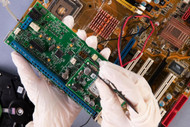The Eco-Friendly Approach to PCB Rework: Reducing Waste and Cost
Posted by Staff - Soldertraining on Aug 9th 2023
With an increased focus on sustainability worldwide, a variety of industries are transforming their practices to limit their environmental impact. Among them is the field of electronics manufacturing, where traditionally, the modification of Printed Circuit Boards (PCBs) has led to substantial waste. However, innovative, greener strategies are rewriting this scenario, not only slashing waste but also bringing down costs.
The Conventional PCB Rework Method
The conventional method of reworking a PCB—which includes identifying and fixing a defect—has traditionally been a wasteful, labor-intensive process. It typically involves removing the defective PCB, diagnosing the problem, replacing the malfunctioning components, and subsequently testing the repaired PCB. Each of these steps contributes to waste generation, including irreparable components, as well as the energy and materials expended in the process.
The Green Way Forward
Enter the greener alternative to PCB rework, a strategy designed to minimize waste, decrease costs, and still enhance, or maintain, the quality and dependability of the refurbished PCBs. This approach revolves around three key principles: reduce, reuse, and recycle.
1. Reduce: The primary principle, reduce, aims to cut down waste in the rework process. This involves minimizing the use of hazardous substances, cutting down energy consumption, and curbing waste generation. Methods like Lean Manufacturing and Six Sigma are incorporated into rework procedures to eliminate waste, streamline workflows, and decrease variability.
For instance, one recurring problem in reworking PCB is 'rework loops,' where a board undergoes multiple cycles of rework due to incorrect diagnosis or mishandling of the issue initially. By employing Lean Six Sigma techniques, manufacturers can optimize their processes, cut down rework loops, and significantly reduce waste and expenses.
2. Reuse: The second principle, reuse, focuses on prolonging the lifecycle of PCBs and their components. Often, malfunctioning PCBs aren't entirely defective; they may have only one component that's failed. By only replacing the failed components, manufacturers can increase the PCB's lifespan, decreasing the requirement for new PCBs and mitigating manufacturing pressures.
Advanced diagnostic tools like Automated Optical Inspection (AOI) and X-ray inspection are gaining prominence in reworking PCB. These tools enable accurate identification of faulty components, facilitating targeted rework that prolongs the PCB's usefulness and minimizes waste.
3. Recycle: The last principle, recycling, focuses on responsibly discarding PCBs and their components that can't be reworked or reused. Even with the best rework procedures, not all PCBs can be salvaged. When a PCB's lifespan ends, it's crucial to ensure it's disposed of in an eco-friendly manner.
Various recycling methods are being employed to salvage valuable materials from expired PCBs, such as hydrometallurgical processes for precious metals extraction. By recycling these materials, manufacturers can lessen their dependence on raw materials, thereby reducing their environmental impact and potentially cutting costs.
Conclusion
Adopting a green approach to reworking PCB isn't just a passing trend; it's a necessary pivot as industries worldwide grapple with climate change implications. Electronics manufacturers can create a win-win situation by prioritizing reduction, reuse, and recycling in their rework operations. They can simultaneously lessen their ecological impact and bring down costs.





